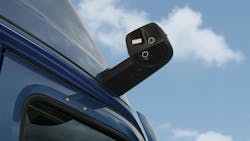Trucking’s mirrorless future is in sight
Are side-view mirrors going the way of film cameras, record players, and VHS movies? While it’s hard to tell when passenger cars will drop their mirrors, a mirrorless future is dawning in heavy-duty trucking.
Stoneridge, which has offered its high-definition camera and display systems that replace side view mirrors as an aftermarket solution for several years, has deals with OEMs to factory-install the MirrorEye in new Class 8 tractors. Most recently, Daimler Truck North America offers the system in the Fifth Generation Freightliner Cascadias, and Volvo Trucks North America offers it in the new Volvo VNL. The Freightliner version is called MirrorCam, and Volvo calls it the Camera Monitor System.
The OEMs are touting the added safety and driver comforts that come with the system, along with fuel savings when the federally required side-view mirrors are removed from the trucks. According to regulations, trucks must be sold with mirrors, but carriers can remove them and use the high-definition alternative.
“Drivers have 40% more visibility just based on the cameras versus what they would have in their traditional mirror,” David Kracirik, Stoneridge director of North American fleet sales, said. “And then they have access to tools to help them tackle different challenges when they’re driving, like enhanced night vision.”
MirrorEye allows tractor-trailer drivers to see things typically hidden in their blind spots while changing lanes on the highway or backing into a loading dock.
The cameras use focused infrared light for night driving and backing up into dark places, he added. Automatic panning, meanwhile, keeps the back of the trailer in view during turns. “That way they can see what’s always in between the front of their tractor and the end of their trailer,” Kracirik said.
Fleet Maintenance, a FleetOwner affiliate, recently took a deep dive into how mirrorless systems work, how to train drivers, and what maintenance requirements fleets should think about as they consider the factory-installed or aftermarket options this decade. Read more from Fleet Maintenance Editor-in-Chief John Hitch.
